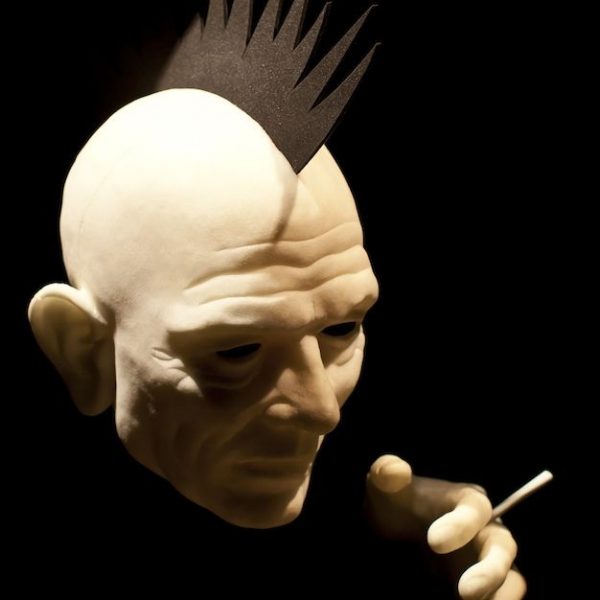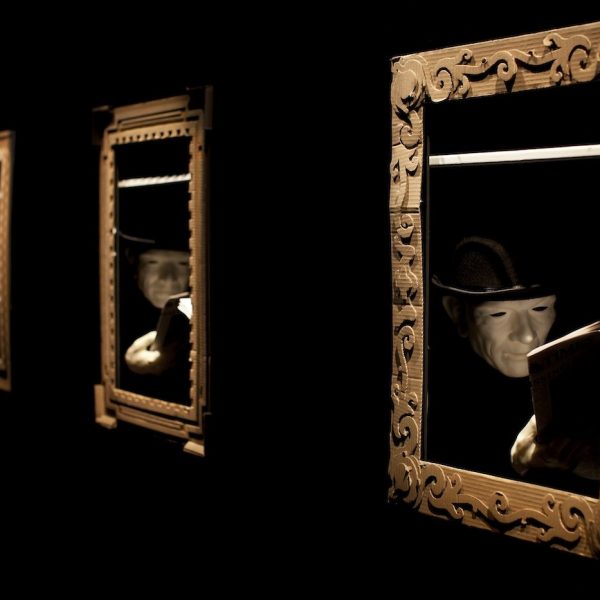
Text by: Joanna Dong 撰文:董一燃
Translated by: Elaine Yu 翻譯:余寧
Blind Summit was founded in 1997 in an attempt to overturn and reinvent Japanese Bunraku Puppetry. People have always visited their productions with great expectation and the plays have often caused surprise. Blind Summit does not repeat itself merely to please audiences, it continuously refreshes, challenging with great courage and poise, as the performance evolves in front of your eyes. In an era where new media dominates the theatrical stage, the calm nature and handling by Blind Summit has brought about astounding performances.
The Heads is quite different from any past production as there are no storylines. Three photo frames made from cardboard paper are hung in the middle of the stage on a black wall, exerting a sense of openness and deepness. Gradually, three white heads appear in the frames, emotionless, without any indication of activities with smells of stillness and death from human body parts. The three heads start to jitter just as we start to doubt their agility and ability to move. It is like observing cell divisions under a microscope, orderly and plentiful, with a good pace. The influence of the music and the surroundings and the illusion of the faces of the stiff heads stimulates emotions and questions. Surprisingly similar to nightmares, The Heads bring us the sensation of mystery, uncertainty and insecurity.
Inspired by Cubism and Surrealism, The Heads has a poetic and philosophical atmosphere. The artist Jon Whitten has composed music specifically for the show and this has brought more possibilities and bigger challenges in blending the two art forms. This eccentric new play of Blind Summit not only challenges our understanding of puppetry, but also our experiences of light, music and vision in theatre.
Innovative use of materials is also ground breaking. The three photo frames are solely made of cardboard, but appear to be made in the classic style of plaster with complicated and heavy detailing with layered carvings, or metal frames with sharpness and rules. We see cardboard with our own eyes, with its untouched original colour and corrugated. Then we no longer see cardboard, this game of illusion allows all possibilities. The puppets heads are made from a milky white silicone mould. Through the strong limelight and the translucent skull can be heard cries creating the image of an unborn baby in a mother’s womb. This peculiar texture is in sharp contrast with the seemingly endless darkness around it, forming a persuasive perception of a dream.
Meanwhile, Blind Summit have not lost their traditional sense of humour: when a flower swaying in the wind turns into a tiny ballerina; when the featureless head wears a top hat and beard, vividly paying respect to Charlie Chaplin, king of silent pictures; when it salutes punk culture with its sharp and pointy hairstyle, while one, two, three pieces of wind are floating in the dark background. You realise that these curious works of arts are not there to judge the appearance of the heads, but to open the gate to fantasy, to bring your soul out of your body temporarily; in order to examine what is really going on in your own head.
In addition to is a solo production Blind Summit has worked with art organizations, including Complicite, ENO, NT; including the unforgettable performance of the weak puppet boy in Anthony Minghella’s production of Madam Butterfly, and the angry dog in A Dog’s Heart by Bulgakov. Blind Summit are modest when they talk about these collaborations as they are happy to share what they are good at with others, and are grateful that the co-productions brought them to another stage.
成立於1997年的盲頂(Blind Summit)始創時試圖推翻和重塑日本的文樂木偶(Bunraku puppetry)。對於他們的作品,人們從來都是充滿期待,但是每每看到的都與預期不同,在不斷自我刷新的道路上,盲頂從未因為要取悅觀眾而重復自己,他們勇敢而沈著地自我挑戰著,並把這過程呈給你看。在一個新媒體占據舞臺的劇場時代,盲頂的處變不驚讓他們的作品每一次出場都很驚艷。
《腦袋腦袋》和以往的作品區別較大,這一次,他們徹底地放棄了故事線索。舞臺正中,一面黑墻上三個紙殼板塑造的相框空曠,深邃。演出開始,燈光強烈的打亮了相框,把裡面的黑色襯托得更加黑暗與神秘。三個白色的腦袋陸續出現在畫面裡,沒有表情,沒有任何活動的機關,甚至很有些像人體標本的那種僵死的恐怖,就在我們質疑它們的靈活與表現力的時候,三個腦袋開始活躍起來。好似顯微鏡下細胞分裂,規律而逐漸豐富。錯覺漸漸產生,在一張張僵硬的面孔裡,你開始在音樂和裝飾的影響下覺察情緒、身份、卻又沒有得到完全的解答。與夢魘有著驚人的相似,《腦袋腦袋》為我們呈現神秘,未知和不安全的觀感。
受到立體主義和超現實主義的啟發,《腦袋腦袋》前所未有地充滿詩意和哲思。更值得一提的是所有的音樂皆為藝術家喬恩·懷恩(Jon Whitten)為本部作品的原創,為這兩種藝術更默契地彼此交融提供了更大的挑戰和更多的可能性。盲頂這一次的作品不僅僅挑戰我們對於木偶本身的認識,更是在挑戰我們對於光、音樂和視覺主導劇場的欣賞體驗。
這一次的創新並沒有止於這些,同樣值得關註的還有對於材質的特別探索。如我們之前提到的,三只相框完全是紙板做的,卻嚴肅地呈現著古典主義的風格,那些層疊的雕花,有著石膏相框的繁復厚重感,或者金屬相框的尖銳和規則。我們明明看到紙板,有著那些甚至不願去修飾的原始顏色和瓦楞,我們看到的卻不再是紙板,錯覺的遊戲讓各種可能性得以呈現。對於木偶本身,這一次的腦袋們使用了乳白色的矽膠質塑造,在強光的投射下,半透明的頭顱有著母體中嬰兒般的意味。這種特別的質感與周邊深邃的黑色產生鮮明的對比,讓夢境的感知更具有說服力。
同時,盲頂並沒有忘記他們慣有的幽默,當一朵在風中搖曳的花朵翻轉變成小小的芭蕾舞者,當那顆沒有任何特征的腦袋戴上禮帽,貼上胡子,生動地為默片之王查理·卓別林致意時,當它頂起尖豎的發型,為朋克文化敬禮時,在一朵、兩朵、三朵、輕巧的雲朵飄在黑色的背景裡時,你終於理解,這個奇妙的作品並不是要審閱這些腦袋的外表,而是要為你打開通往魔幻的大門,暫時靈魂出竅,去審視你自己的腦袋裡,究竟在想點什麽。
盲頂劇團在自創劇目的同時也和很多藝術機構有著跨界合作。包括卡姆普利賽特(Complicite)劇團,英國國家歌劇院(ENO)以及英國國家劇院(NT)。比如在安東尼·明格拉(Anthony Minghella)的《蝴蝶夫人(Madame Butterfly)》中出現的那個讓人難忘的羸弱的木偶男孩,或者是布爾加科夫(Bulgakov)的《狗心(A Dog’s Heart)》中那只猙獰的狗。盲頂在闡述這些合作時,謙虛地談到他們很榮幸能把自己所熟知的東西與他人分享,同時也感謝這些合作把盲頂的作品帶到了另一個舞臺。













